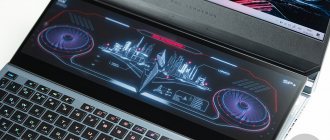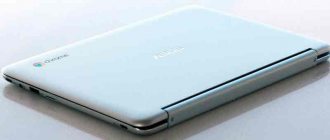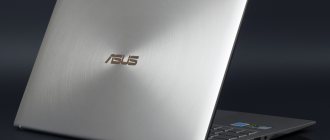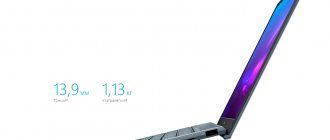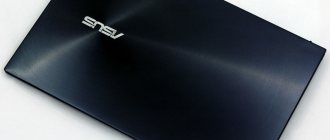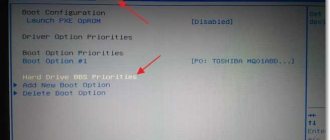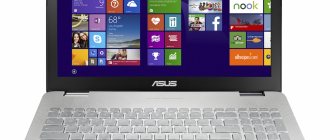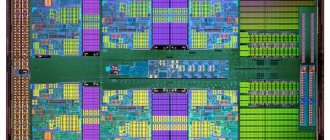For a long time, transformable laptops were considered toys, fashion accessories, but not full-fledged work devices. Alas, in those days it was impossible to install truly productive hardware in the thin cases of such models. The low-watt, dual-core, and as a result, not the fastest processor did not allow working comfortably. Now, with the advent of the 8th generation Intel Core processors, the situation has changed, and Transformers have new chances for success. You don’t have to look far for examples - the Asus ZenBook Flip 14 has a 4-core processor, a discrete graphics card and weighs 1.5 kilograms.
Specifications Asus ZenBook Flip S
The ZenBook Flip S features an interesting combination of colors without making the design seem too flashy or provocative. Concentric rings on the lid and diamond-cut edges emphasize that this is an expensive laptop.
The build quality is high - despite its lightness, the laptop maintains balance in any position. With a weight of 1.1 kg and a thickness of 1.1 cm, the ZenBook Flip S is only 230 g heavier than the ZenBook 3. But, it can be used in 4 modes: Notebook, Tablet, Tent and Multimedia. The laptop's narrow frames didn't stop Asus from placing a webcam above the display.
The design uses aircraft-grade aluminum alloy, which is 50% stronger than usual. The Asus ZenBook Flip S feels like a solid piece of metal. The hinge rotates easily in tablet mode and holds the screen stably.
A powerful processor heats up, and a weak cooling system is powerless. The case becomes especially hot in the lower part.
Review of the ASUS ZenBook 14 UX434FLC ultrabook
Table of contents
- Introduction
- Specifications
- Appearance and design
- Keyboard and touchpad
- Display
- Software and firmware
- Hardware platform and performance
- Multimedia
- Wireless Interfaces and Security
- File system
- Battery life
- Conclusion
Introduction
Modern computer technology is developing quite actively.
New generations of laptops are constantly being developed and offered, and data transfer and storage technologies are being updated. In particular, central processors are also being updated. As an example, we can recall modern processors from the AMD Ryzen family, which are actively improving AMD’s position in the laptop market. Intel also does not stop in its developments, and today we will talk about a new ultrabook model with a body already familiar to us, but with a completely new hardware platform.
We received the ASUS ZenBook 14 UX434FLC for testing. This is a new model that will go on sale a little later, but already now it gives you the opportunity to get acquainted with the new generation of processors.
Specifications
| Device type | Laptop |
| Model | ASUS ZenBook 14 UX434FLC |
| CPU | Intel Core i5-10210u / Intel Core i7 10510u |
| Video processor | NVIDIA GeForce MX250 |
| operating system | Microsoft Windows 10 |
| RAM, GB | 8 / 16 |
| Built-in memory, GB | 256 / 512 / 1024 |
| Screen | 14″ IPS, 1920 x 1080 |
| Wireless interfaces | Wi-Fi 6; Bluetooth |
| Battery, Wh | 50 |
| Dimensions, mm | 319 x 199.5 x 17.5 – 18.2 |
| Weight, kg | 1,25 – 1,33 |
| price, rub. | From 85 990* |
*Price recommended by the manufacturer.
The final cost depends on the specific modification. announcements and advertising
2080 Super Gigabyte Gaming OC for 60 rubles.
Compeo.ru - the right comp store without any tricks
RTX 2060 becomes cheaper before the arrival of 3xxx
Ryzen 4000
series included in computers already in Citylink
The price of MSI RTX 2070 has collapsed after the announcement of RTX 3xxx
Core i9 10 series is half the price of the same 9 series
The price of memory has been halved in Regard - it’s more expensive everywhere
As you can see, apart from the use of new generation processors, no discoveries happened. However, the overall level of equipment characterizes this model as optimal for any task by the standards of compact ultrabooks.
Appearance and design
We are already familiar with the design and construction of the case. For example, the recently tested ASUS ZenBook 14 UM433D was built in the same case, although with some differences. The body is assembled from metal panels. In this case, it is made in dark blue.
In the center there is a metallized manufacturer's logo with concentric grinding lines diverging towards the edges. This allows the lid to play very interestingly in the light.
The interior decoration is decorated in dark blue. The display frame is black and almost merges with the switched off screen.
The only light accent is the narrow insert above the keyboard. It is made in golden color and bears the logo of the manufacturer and model range.
On the left side there is a power connector, as well as the following ports: HDMI, USB-A 3.1 Gen 2, USB-C 3.1 Gen 2.
On the right you can see a combined 3.5 mm audio jack, a USB-A 2.0 port and a slot for microSD memory cards. There are also LED indicators for activity and power.
The lower part is closed by a single metal lid; it is devoid of any additional compartments and rests on the surface with large rubber feet. Here you can see two oval speaker grilles and a wide grille for air access to the cooling system.
It is fixed in place with latches around the perimeter and small screws. We remove the cover and evaluate the internal configuration of the device.
As you can see, the components are arranged quite tightly and closely. Although the small amount of free space near the battery hints that they were a little modest with its capacity. Most likely, this happened to reduce the overall mass.
Keyboard and touchpad
The keyboard configuration is typical for modern ZenBook models. It is made of an island type, the surface of the keys has a slightly concave shape for more comfortable typing, and the spaces between the buttons are large enough to minimize accidental presses.
The keys themselves are painted in the color of the body with light engraving of the symbols. We received a test sample with a Latin layout for testing, and bilingual versions will be available for sale. There is a white LED backlight with three brightness levels.
The traditional touchpad is replaced by a large TouchPad ScreenPad 2.0. The classic cursor control device is combined with an additional display, which expands the scope of application.
A high-quality IPS display with Full HD resolution and wide viewing angles is used.
So, here you can launch built-in widgets that make it easier to work with various tasks. For example, you can display a numeric keypad for performing calculations or entering numeric data. And you can use this space as an additional display, displaying any necessary information.
Display
In the best traditions of modern ultrabooks, an IPS matrix with a resolution of 1920 x 1080 pixels is used. The display diagonal, as the name suggests, is 14 inches. And if we are talking about finding a universal device, this option looks optimal. It allows you to combine a working space sufficient for comfortable operation with compactness and low weight. It turns out to be a reasonable compromise.
Our modification supports touch input and is covered with glossy glass. Non-touch options are also available. While the touchscreen adds convenience, it's not a necessary feature. It's all in the software part. The modern version of the operating system has learned to work correctly with touch controls, but it still remains “tailored” for cursor control. However, this is a good foundation for the future.
Thanks to the use of an IPS matrix, it was possible to achieve bright color reproduction and wide viewing angles. When viewed from an angle, the brightness is only slightly reduced without affecting the overall impression of image quality.
Using a colorimeter, we tested the backlight brightness and the quality of the factory color calibration.
| Brightness level, % | White brightness, cd/m2 | Black brightness, cd/m2 | Contrast, x:1 |
| 100 | 340 | 0.303 | 1122 |
| 50 | 133 | 0.119 | 1118 |
| 0 | 19 | 0.017 | 1118 |
The display has a high level of contrast. This was achieved thanks to a sufficient margin of the maximum brightness level and a low brightness level of the black field.
Gamma curves are located as close as possible to the reference value. Minimal deviations are noticeable in the graph, but will not affect the overall impression of color rendering.
In the second graph, the indicators of each color are also distinguished by their proximity to the reference and stability throughout the entire graph.
The color temperature is also precisely tuned - the manufacturer has maintained an exact match to the natural display, without bias towards cold or warm shades.
The color range almost completely corresponds to the generally accepted RGB standard. There is a slight lack of blue and green tints that will not have a noticeable impact on the overall image experience.
The points of the gray wedge are located within the boundaries of the delta - this is a positive indicator, implying the absence of spurious shades and contributing to accurate color reproduction.
The manufacturer always pays special attention to the issue of display quality. This allows you to achieve comfortable operation of the laptop. In this case, the display received high-quality color calibration. The only controversial point was the slight lack of color range in comparison with the declared 100% compliance with the RGB space. However, this inaccuracy is minimal, does not affect the overall impression in any way and can be considered a normal measurement error.
Software and firmware
Like all other laptop models of the company, our hero runs on the Microsoft Windows 10 operating system. Licensed copies of the home and professional versions will be available.
In our case, the professional version was used, but without license activation - the nuances of the test samples. However, this does not in any way affect the performance characteristics and test results.
Hardware platform and performance
Probably, this model is of greatest interest to us thanks to the processor used. Or rather, the generation of this processor. As you can see from the branded sticker on the case, the tenth generation Intel Core i7 processor is used here. He is interesting because he is the first representative of this generation to come to us for testing.
The Intel Core i7-10510u chip is used. It belongs to a series of low-voltage processors designed specifically for use in ultrabooks. This is a quad-core processor with a base clock speed of up to 1.8 GHz, with the ability to increase it to 4.9 GHz in TurboBoost mode. Each core is capable of processing data in two threads simultaneously.
The processor is made using a 14 nm process technology and is dated the third quarter of 2020. The estimated TDP level is 15 Watts.
Graphics processing was entrusted to a discrete video card NVIDIA GeForce MX250 with its own memory capacity of 2 GB. This is the optimal solution for all use cases, with the exception of the most resource-intensive applications, such as modern games.
The amount of RAM can be 8 or 16 GB. In any case, the memory will be soldered on the board and will not be upgradeable.
Let's look at the test results in various applications. Given the use of a new hardware platform, this should be the most interesting.
As you can see, the new chip provides very solid performance by ultrabook standards, especially when combined with the use of a discrete graphics card. It turns out to be a good option for everyday use on the road, in the office, at home. Despite its compact dimensions, our hero is able to provide the user with sufficient performance for everyday use.
What about the cooling? After all, a compact case is a serious limitation for the placement of a cooling system, and the desire for minimal weight does not benefit this parameter. And although they try to optimize the operation of the hardware platform, heat generation cannot be completely eliminated.
To remove heat, the new model uses a heat pipe that connects directly to the central processor and video card chip. Heat is transferred to the radiator, which is blown by a fan (5 V). Air intake occurs at the bottom of the case, some of it goes directly to the fan, and some blows on all the components. Warm air is blown towards the display. This way, cold and warm air do not mix.
The effectiveness of such a solution can be assessed by testing in specialized stress tests.
Even with prolonged use under load, the case becomes only barely warm, and the cooling system does not create noticeable noise. In a completely silent room, the fan operation can be heard at maximum load, but any extraneous noise will make it completely unnoticeable. If we talk about everyday use, the cooling system often goes into passive mode altogether.
It’s safe to say that the new product has no heating problems. This was achieved by using sufficient cooling, as well as optimizing the operation of components.
Multimedia
Sound output is assigned to two large speakers operating in stereo mode and located to the left and right of the user. Their grilles are placed on the bevel of the back cover and do not overlap even when installed on a medium-hard surface.
To avoid resonance with the body, the speakers are fixed to the body through special rubber spacers. They can be seen in the photo of the interior.
The use of SoniMaster proprietary audio technology involves a set of software settings and the use of an intelligent audio amplifier. This allows for a wide frequency response while minimizing distortion at maximum volume.
In practice, the laptop shows a solid volume reserve, allowing you to comfortably use the built-in speakers even in the presence of background noise. Regardless of the volume level, the sound is perceived clean and without a pronounced deficit of low or high frequencies.
Wireless Interfaces and Security
There is no RJ-45 port on the ultrabook case - a tribute to compactness and modern trends. Although, it is possible that the delivery package will include an adapter for connecting a network cable via USB. But they paid due attention to working with wireless networks. Taking into account modern trends, the manufacturer used a modern Intel Wi-Fi 6 wireless communication module with a 2x2 antenna cascade. This made it possible to ensure high data transfer rates with minimal interference, even in difficult conditions.
A Bluetooth v5.0 module is provided for synchronization with wireless accessories and file transfer.
Traditionally, modern ZenBook models have an infrared front camera. It performs facial recognition, working in conjunction with the built-in Windows Hello feature. Even in low light conditions, the system quickly detects the user's face and unlocks the system if a match is found.
File system
There are several options for file storage capacity – 256, 512 or 1024 GB. In any case, modern M.2 solid-state drives with a PCI-e interface are used.
In our case, we used a 512 GB Intel Optane Memory H10 drive. As we can see, the manufacturer strives not only to provide its new product with maximum figures in technical characteristics, but also pays due attention to the selection of high-quality components.
The file system speed was tested using the Crystal Disk Mark application.
Battery life
The battery capacity is 50 Wh. It is integrated and is not intended to be dismantled outside the service center. The energy reserve is large, taking into account the compact body and low weight.
However, one of the trends in the development of modern components is energy saving, and this plays into the advantage of autonomy. Taking into account the use of the latest generation processor, the issue of autonomy becomes even more interesting. However, we must remember that this is a test sample and work on optimizing the software to work with the new generation is still underway.
Nevertheless, we can evaluate the preliminary results now and, first, let’s estimate the duration of our hero’s operation in idle mode. Let's turn off all background applications and the display, put the computer into energy-saving mode. The result of nine hours is quite good, although we have seen better ones.
To simulate operation under average load, let's start continuous playback of YouTube videos in 1080p quality using the Microsoft Edge Internet browser. The laptop operating mode is set to “performance priority”, the display brightness is at the maximum level. The result was about 3.5 hours. A similar test was carried out with an active additional display in duplication mode. The activity of the second display expectedly increased power consumption, and the result was about 30 minutes less.
Finally, we simulate the maximum load using a stress test. In this case, the display brightness is set to the maximum level, and the laptop is switched to maximum performance mode. As last time, testing was carried out with one display and in duplicate mode. The results were 1 hour 30 minutes and 1 hour 20 minutes respectively.
The power adapter is small in size and will allow you to take it with you if the energy supply may not be enough. Output power is 65 Wh.
In general, our hero’s autonomy turned out to be at a good level. Yes, this is far from the record figure we know of, but it is solid, especially considering performance.
Moreover, as the software is updated, the efficiency of the hardware platform should increase, and this will allow the ultrabook to show more impressive battery life results.
Conclusion
It is gratifying to see that as manufacturers develop new generations, they are achieving increasingly worthy results in an effort to achieve greater efficiency. Work is being carried out in several directions at once. Developers are striving to increase the performance and stability of components and reduce power consumption. This allows you to achieve less heating of the case and better autonomy with the same battery capacity. Not only are laptops becoming smaller, lighter and thinner, but they are also improving in terms of performance.
The new generation of Intel processors pleased us with modest heating under load, good stability and sufficient computing power. The user does not have to limit his requests and choose between performance and compactness. Of course, there is no need to talk about performance at the level of flagship or gaming solutions, but the tasks for ultrabooks are set differently.
The new product from ASUS is one of the first devices running on tenth generation Intel processors. And in addition to being progressive, it is distinguished by a high-quality body and stylish design. They did not skimp on the quality of the display, equipping it with touch control capabilities. And to achieve maximum versatility and practicality, the classic touchpad was replaced with ScreenPad 2.0 (combining the touchpad with an additional display). This technology is a proprietary feature of ASUS laptops and is not available in models from other companies.
With a solid level of performance, you won't have to sacrifice autonomy. The energy reserve is quite enough for a working day in office mode, for which these ultrabooks were developed in the first place. Yes, multimedia tasks will require the activity of a discrete graphics card and will reduce the operating time without recharging, but even in this case, the user will not have to constantly look for an opportunity to recharge. However, if you need to store the charger with you, its compact size will reduce discomfort to a minimum.
The overall balance and thoughtfulness of the ASUS model creates the feeling of a finished product that you don’t want to fix or finish in any way. Probably, this is exactly the goal result - to provide the user with an ideal product.
Alexey Pashchuk
Based on the review results, the ASUS ZenBook 14 UX434FLC laptop receives the following award:
We express our gratitude to:
- To the Russian representative office of ASUS for providing the ASUS ZenBook 14 UX434FLC laptop for testing.
Connectors and ports
Compact laptops leave little room for ports. For example, MacBook and ZenBook 3 have only one USB 3.1 Type-C connector, so you have to use adapters or USB hubs.
The ZenBook Flip S has two Type-C ports and a 3.5mm headset jack, which is better than the competition, but connectivity is still limited. Any port can be used to charge the device, including through adapters from third-party manufacturers.
The kit includes a docking station with another Type-C connector, an HDMI port and USB 3.0 Type-A. The station matches the Flip S style and looks appropriate when connected.
Advanced technology and high performance
ASUS ZenBook Flip 14 UX461 uses the latest components, including eighth generation Intel Core processors. At the moment, modifications of ASUS UX461UA-E1012T and ASUS UX461UN-E1063T are on sale. Their key characteristics are summarized in the table.
| Model | ASUS UX461UA-E1012T | ASUS UX461UN-E1063T |
| Screen | 14″, 1920 x 1080, IPS | 14″, 1920 x 1080, IPS |
| CPU | Intel Core i5-8250U | Intel Core i7-8550U |
| RAM | 8 GB 2133 MHz | 8 GB 2133 MHz |
| Drives | 256 GB SSD | 512 GB SSD |
| Discrete graphics card | — | NVIDIA GeForce MX150 2 GB GDDR5 |
| Net | Wi-Fi 802.11 ac Dual-band | Wi-Fi 802.11 ac Dual-band |
| Audio | Harman Kardon speakers with two-channel amplifier | Harman Kardon speakers with two-channel amplifier |
| Battery | 57 Wh | 57 Wh |
The Core i5-8250U and Core i7-8550U processors differ in clock speed: 1.6-3.4 GHz versus 1.8-4.0 GHz. Both models comply with a TDP level of 15 W. The capabilities of the integrated video core will be sufficient only for not the most demanding games like Team Fortress 2 and FIFA 17, and even then you will have to sacrifice graphics settings. The engineers also provided 8 MB of third-level cache.
Also, different versions of ASUS ZenBook Flip 14 UX461 differ in the size of the solid-state drive (256 or 512 GB) and the presence or absence of a discrete NVIDIA GeForce MX150 2 GB GDDR5 graphics card. At the moment, it represents the entry level, but even taking this into account, the GeForce MX150 is several times faster than the Intel UHD Graphics 620.
Flip S keyboard
It's amazing that the Asus ZenBook Flip S fits a full-size keyboard, and every key is pressed clearly and accurately. Golden backlight with three brightness levels does not irritate the eyes. It's not the best keyboard in the world, but it's great for such a thin device.
The ZenBook Flip S's large, smooth touchpad supports all Microsoft Precision multi-touch gestures. The integrated touchpad buttons perceive clicks on too small an area - you have to constantly look at them so as not to make a mistake.
The 10-point touch display is very accurate and responsive. The surface of the screen seems sticky, so for control it is better to use an active stylus that recognizes 1024 levels of pressure sensitivity.
The Flip S' fingerprint sensor is located on the right side, it accurately identifies the owner and supports passwordless login via Windows 10 Hello.
Keyboard and touchpad
The keyboard does not have a number pad, but the keys themselves are large and have good tactile feedback. The key travel is 1.4 mm, there is a backlight. What I especially like here, unlike, for example, ASUS VivoBook F510UA, is that the power button is not disguised as one of the buttons on the keyboard. I don't think this is a big drawback, but I would definitely accidentally click on it once or twice.
The touchpad is glass, with an optional fingerprint scanner and recognition of up to 4 touches. Windows Hello feature supported.
Laptop display
Asus ZenBook Flip S only offers Full HD resolution (1920 x 1080) - and this is enough, considering that the diagonal is 13.3 inches. 70% of the AdobeRGB color range and 94% of sRGB are covered - slightly more than on the equally thin and light Acer Spin 7. Color accuracy is 2.82 - less than 1.0 is considered ideal.
The brightness is 285 nits, which is not enough for working in strong lighting conditions, at least 300 nits is recommended. Due to the 2.4 gamma, dark scenes in films look worse. Contrast ratio - 720:1. For comparison, the Dell XPS 13 2-in-1 QHD+ resolution, brightness is 251 nits, contrast ratio is 1120:1.
Despite the mediocre performance, the ZenBook Flip S's display is pleasant to work with, and the weak contrast does not prevent black text from appearing clearly against a white background. Most users will be happy with the quality of the screen, only professionals will need better color accuracy.
Speakers and sound
Asus and Harman Kardon have created a good audio system for the Asus ZenBook Flip S. There is even a separate IcePower AudioWizard application for setting up speakers, in which you can set the volume to maximum and select the mode: Music, Video Recording, Game or Speech.
The sound quality is excellent for watching videos, but there is some serious distortion at maximum volume. There is no bass.
Performance processor
Asus has installed an Intel Core i7-7500U, which puts the ZenBook Flip S ahead of competitors with low-power chips, such as the Dell XPS 13 2-in-1 with a Core i7-7Y75.
In the benchmark Geekbench 4 test, the laptop scored 4,142 points in single-core mode and 8,158 in multi-core mode. The thicker HP Specter x360 scored 3,837 and 6,401, respectively.
In the system-intensive Handbrake test, which requires video encoding in H.265, everything took the Asus ZenBook Flip S longer than its competitors, and the processor may overheat. It completed this test in 1,477 seconds; the HP x360 Specter with the same processor completed encoding in 1,095 seconds. The Dell XPS 13 2-in-1 and Acer Spin 7 did it in 2,027 and 1,751 seconds.
The ZenBook Flip S doesn't get too hot during web browsing, emailing, and other everyday tasks, so the powerful processor usually doesn't get in the way of holding the laptop on your lap.
Solid State SSD
A solid-state drive (SSD) with a SATA interface is installed to store information. Asus promises to soon introduce models with PCIe SSDs. SATA provides good performance, but lags behind PCIe - this is best seen in the CrystalDiskMark test.
The Sandisk X400 512 GB SATA SSD installed on the Asus ZenBook Flip S showed a read speed of 459 MB/s and a write speed of 411 MB/s. For comparison, the Samsung PM961 PCIe on the Lenovo Yoga 720 has a read speed of 2,060 MB/s and a write speed of 1,209 MB/s.
However, when surfing the web and checking email, maximum speed is not needed, and files and applications on the Flip S open without delay. The advantage of SSD PCle is noticeable only if you work with large amounts of information.
Performance
Thin laptops are in most cases considered low-performance by default. A few years ago, this was usually the case. But with the latest 8th and 9th generation Intel processors, high performance has become available even in the ULV (Ultra Low Voltage) segment. Well, as I said above, the processors used in this laptop are the most advanced ones. If we take the popular Cinebench R15 and the no less popular Intel 7700HQ for testing for comparison, the latest Core i5 8265U will show 570 points, and the Core i7 7700HQ will show 670 points. Those. the difference in computing power is no more than 15%, and then in pure synthetic conditions. When working with real applications, you will hardly be able to notice this difference. And so, the i5 8265U processor offers the same 4 cores, 8 threads and 6 MB of third-level cache. The only difference is a slightly lower frequency, but it has a new microarchitecture. In other words, we get almost the same performance, but with much lower power consumption, which means less heat and longer battery life. This is progress.
If you are interested in the speed of a solid-state drive (SSD), then ASUS was not greedy and installed a good SSD, the read speed of which reaches 3400 MB per second. The recording speed reaches 2000 MB per second. In other words, you won’t have to waste your time waiting for applications to load, the system flies.
Only game lovers can have complaints, but guys, Zenbooks have never been considered gaming solutions, and the built-in is simply not designed for this. However, this does not prevent you from setting up tanks or counters and playing at medium quality settings if desired.
Equipment not for gaming
The Asus ZenBook Flip S laptop is practically unsuitable for gaming - there was no room for a separate video card, and the integrated Intel HD graphics are too weak.
In the Fire Strike test, the Flip S scored 997 points - on par with other hybrid laptops that can't handle anything but old games. For example, the puzzle game Candy Crush will run without problems, but with a resolution of 1080p and medium detail, the frame rate in Civilization VI was 12 fps. When selecting ultra detail, performance will drop to 6 fps. As you can see, it is impossible to play on any settings.
Transformable ultrabook from ASUS
One of the obvious advantages of the updated device is the optimal size for those who are looking for a computer assistant that can be taken with them everywhere. Long-term battery life is ensured by a high-energy battery that supports fast charging technology. The format of the ASUS ZenBook Flip 14 laptop is optimal for both office work and surfing and typing. Taking into account the thin frames (only 4.3 mm), it seems that this is a 15-inch ultrabook. The total usable area is 90%. Detailing and color rendition are at a high quality level. It offers a touch display based on an IPS matrix FullHD format (1920×1080 pixels) with a frequency of 60 Hz, a color palette of 72% NTSC format and wide viewing angles (178 degrees). There is LED backlighting and the screen type is glossy. Thanks to the 360-degree rotating top part, the device can be used as a large and convenient tablet. The hinges are reliable and do not cause any concern. Support for more than 20,000 opening-closing cycles is declared. The hinge itself is made in the ErgoLift form factor - the concept of raising the upper part to a certain angle and height. This not only makes printing more convenient, but also simplifies the operation of the cooling system (more air gets in and hot masses are removed more efficiently from key components). Another significant advantage of the improved display is its energy efficiency. This point had a positive effect on the overall battery life. A significant argument in favor of buying the ASUS ZenBook Flip 14 UX463FL is the presence of a fast and very responsive ScreenPad 2.0 touchpad. Using this additional screen, the user can perform certain actions at his own discretion (quickly launch applications, view photo and video content, view information in the browser), chat and other types of communication in instant messengers and third-party programs.
The second 5.65-inch display is a pleasure to use. The updated version is distinguished by the unification of the software shell, which can be used by everyone without exception. The interface and appearance of the shell are very similar to a smartphone. Many useful technologies are supported: handwriting input, quick dialing of numbers, as well as quick input of long key sequences. Even more convenient and intuitive workspace. Representatives of creative professions and specialties will appreciate it. The laptop dimensions are as follows: 320 x 206 x 17.9 mm, weighing 1.4 kg. If you remove the battery, the weight will be around one kilogram. Windows 10 Pro is preinstalled as the operating system. Having provided for the need for external connection of various devices and gadgets, the designers placed a combined audio jack, a microSD card slot, a USB 2.0 port, full-size HDMI, USB 3.1 and USB-C 3.1, both second generations with high bandwidth, on both sides of the case.
Long lasting battery
This compact laptop fits a battery with a capacity of only 39 watt-hours. In Basemark's most demanding test, the battery lasted about 2.5 hours - a decent result considering the powerful components of the system. When playing video, the Asus ZenBook Flip S battery ran out in 9.5 hours, which is about the same as competitors and an hour less than the XPS 13 2-in-1. In the test of opening looped web pages, the Asus laptop drained in 6 hours - not bad, although 1.5 hours less than the XPS 13 2-in-1.
The Flip S's performance is good enough for long-lasting battery life, although it won't last all day under heavy loads. Fast charging technology allows you to charge the battery from 0 to 60% in 49 minutes - a useful feature in a pinch.
Screen
The laptop is equipped with a FullHD (1920x1080) IPS touch screen. The matrix used is BOE NV140FHM-N62. The specifications for it indicate that the brightness is 300 cd/m2, the contrast is 800:1, and the frequency is 60 Hz. When measured, the contrast turned out to be even higher, just over 1000:1.
As for the color gamut, the ASUS website indicates that it is 100% sRGB and 72% NTSC. However, this is not far from the truth. The measurements showed 90% sRGB coverage. There's nothing wrong with the screen. The response time is typical for IPS panels and is 30 ms.
Unfortunately, there is PWM in the range from 0 to 99% brightness. To get rid of this unpleasant process for some, you will have to turn the brightness to maximum.
In general, the screen is very good, especially with color, everything is excellent, for which we must thank the wide color gamut. But the presence of PWM brightness control worsens the impression, and when working on a sunny day, when light hits the screen, it can “blind”. This is further aggravated by the glare coating.
Bottom line
The convertible Asus ZenBook Flip S is one of the few hybrid laptops that can actually be used as a tablet. Stylish and compact, with a 360-degree flip-out screen, it exudes performance, quality and elegance.
Two USB Type-C ports and a miniature docking station with additional connectors allow you to connect various accessories. Thanks to its modern design and components, the ZenBook Flip S will remain relevant for at least several years - just don't put it on your lap under heavy loads.
Are there any alternatives?
There are many hybrid Windows PCs, but those that are comparable in compactness to the ZenBook Flip S have a weak processor. The main competitor is the Dell XPS 13 2-in-1, which is 1.37 cm thick and weighs 1.22 kg. A configuration with 16 GB of RAM and a 512 GB SSD is available for $1,600 (93,000 rubles) - that is, the heavier and thicker laptop from Dell costs $200 more than the Flip S.
Acer Spin 7 with a 14-inch display is another hybrid laptop. Due to the Full HD resolution, the image on its large screen is not clear enough. There are no models with similar components; for 8 GB of RAM and a 256 GB SSD drive you will have to pay $1,250 (RUB 72,500). Yes, it is cheaper, but the performance, battery life and build quality of the Spin 7 are worse.
Those who do not need thinness and lightness should pay attention to the HP Specter x360 - long battery life, no overheating problems, 16 GB of RAM and a 512 GB PCIe SSD for $1,350 (78,500 rubles).
Benefits of Asus ZenBook Flip S
- Excellent build quality
- Elegant and sophisticated design
- High performance
- Comfortable keyboard
- fair price
Disadvantages of ZenBook Flip S
- Weak display
- The case heats up
Appearance
It's hard to complain about the design of this laptop. Made entirely of aluminum, very rigid, excellent resistance to pressure and twisting attempts. And all this in a thin body of less than 14 mm.
True, there is something to complain about. The screen opens easily, but in laptop mode the hinges may not be rigid enough. No, there is no question of unauthorized increase or decrease in the opening angle of the lid, but the screen may sway. There is one more point that follows from the dimensions of the laptop.
If you open the screen to a larger angle, a redistribution of weight occurs, the front part of the case, the one closest to the user, is unloaded, and although there are no attempts to fall “on the back”, the front rubber feet no longer begin to do their job well and the laptop easily move from place.
And yet the laptop looks great. Thanks to the thin bezels around the screen, just over 7 mm, which makes the laptop visually look like a 13-inch model rather than a 14-inch one. However, the thin frames did allow the body to be slightly smaller
